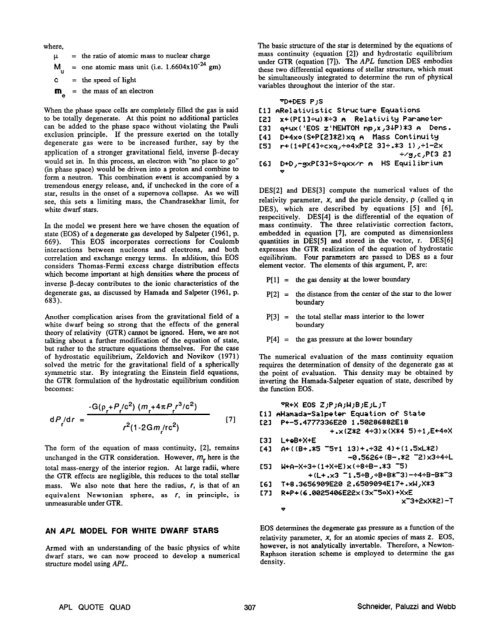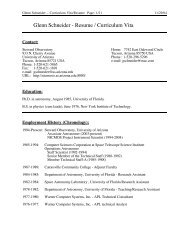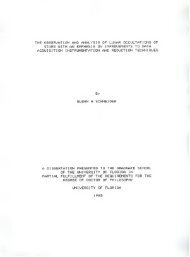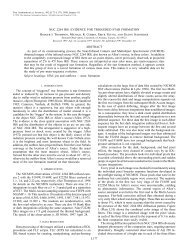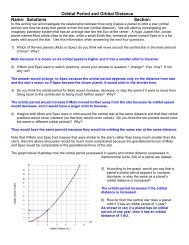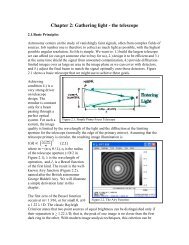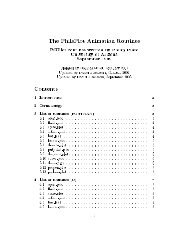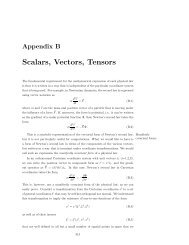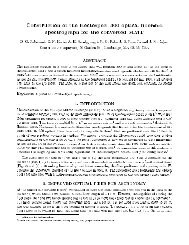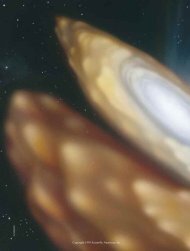ASTROPHYSICAL APL - DIAMONDS IN THE SKY
ASTROPHYSICAL APL - DIAMONDS IN THE SKY
ASTROPHYSICAL APL - DIAMONDS IN THE SKY
Create successful ePaper yourself
Turn your PDF publications into a flip-book with our unique Google optimized e-Paper software.
where,P = the ratio of atomic mass to nuclear chargeMU = one atomic mass unit (i.e. 1.6604x10-% gm)Cme= the speed of light= the mass of an electronWhen the phase space cells are completely filled the gas is saidto be totally degenerate. At this point no additional particlescan be added to the phase space without violating the Pauliexclusion principle. If the pressure exerted on the totallydegenerate gas were to be increased further, say by theapplication of a stronger gravitational field, inverse P-decaywould set in. In this process, an electron with “no place to go”(in phase space) would be driven into a proton and combine toform a neutron. This combination event is accompanied by atremendous energy release, and, if unchecked in the core of astar, results in the onset of a supernova collapse. As we willsee, this sets a limiting mass, the Chandrasekhar limit, forwhite dwarf stars.In the model we present here we.have chosen the equation ofstate (EOS) of a degenerate gas developed by Salpeter (1961, p.669). This EOS incorporates corrections for Coulombinteractions between nucleons and electrons, and bothcorrelation and exchange energy terms. In addition, this EOSconsiders Thomas-Fermi excess charge distribution effectswhich become important at high densities where the process ofinverse p-decay contributes to the ionic characteristics of thedegenerate gas, as discussed by Hamada and Salpeter (1961. p.683).Another complication arises from the gravitational field of awhite dwarf being so strong that the effects of the generaltheory of relativity (GTR) cannot be ignored. Here, we are nottalking about a further modification of the equation of state,but rather to the structure equations themselves. For the caseof hydrostatic equilibrium, Zeldovich and Novikov (1971)solved the metric for the gravitational field of a sphericallysymmetric star. By integrating the Einstein field equations,the GTR formulation of the hydrostatic equilibrium conditionbecomes:dPrldr =-G(pr+Pic2)(mr+4nPrr3/c2)r2( 1 -2Gmjrc2)The form of the equation of mass continuity, [2], remainsunchanged in the GTR consideration. However, /?7, here is thetotal mass-energy of the interior region. At large radii, wherethe GTR effects are negligible, this reduces to the total stellarmass. We also note that here the radius, f, is that of anequivalent Newtonian sphere, as r, in principle, isunmeasurable under GTR.AN <strong>APL</strong> MODEL FOR WHITE DWARF STARSArmed with an understanding of the basic physics of whitedwarf stars, we can now proceed to develop a numericalstructure model using <strong>APL</strong>.[71The basic structure of the star is determined by the equations ofmass continuity (equation [2]) and hydrostatic equilibriumunder GTR (equation [7]). The <strong>APL</strong> function DES embodiesthese two differential equations of stellar structure, which mustbe simultaneously integrated to determine the nm of physicalvariables throughout the interior of the star.OD+DES P;SCl1 0Relatiuistic Strut ture EquationsC23 x+(PCll+u)*+3 0 Relativity ParameterC31 qcux(‘EOS z’NEWTON np,x,3LP)t3 FI Dens.t41 Dc4xo (ScPC23t2) xq FI Mass ContinuityC51 r+(l+PC43+cxq,+04xPC2 31+.*3 1),+1-2x+/g,c ,PC3 23C61 D+D,-gxPC3l+Ssqxx/rvft HS EquilibriumDES[2] and DES[3] compute the numerical values of therelativity parameter, X, and the paricle density, p (called q inDES), which are described by equations [5] and [6],respecitively. DES[4] is the differential of the equation ofmass continuity. The three relativistic correction factors,embedded in equation [7], are computed as dimensionlessquantities in DES[S] and stored in the vector, r. DES[6]expresses the GTR realization of the equation of hydrostaticequilibrium. Four parameters are passed to ‘DES as a fourelement vector. The elements of this argument, P, are:P[l] = the gas density at the lower boundaryP[2] =P[3] =P[4] =the distance from the center of the star to the lowerboundarythe total stellar maSs interior to the lowerboundarythe gas pressure at the lower boundaryThe numerical evaluation of the mass continuity equationrequires the determination of density of the degenerate gas atthe point of evaluation. This density may be obtained byinverting the Hamada-Salpeter equation of state, described bythe function EOS.OR+X EOS Z;P;AjWjBjE;LjTCl1 Aiamada-Salpeter Equation of StateC21 P+-5.4777336E20 1.50286882E18+.x(2X2 4+31x(X*4 5)+l,E+40XC 31 L+eB+X+EC41 A+( (B+.tS -5~1 13)+.+32 4)+(1,5xLt2)-0.5626+ (B- .t2 -2) x3+4+LC51 W+A-X+3+(1+X+E)x(+8+B-.t3 -5)+ CL+ .x3 -1,5+B,+B+Bt-31-+4+B-Bt-3C61 Tc8.3656909E20 2.6509094El7+.xW,Xt3C71 R+P+(6.0025406E22~(3~‘50X)+XxE0x-3+2xX*2 1 -TEOS determines the degenerate gas pressure as a function of therelativity parameter, X, for an atomic species of mass Z. EOS,however, is not analytically invertable. Therefore, a Newton-Raphson iteration scheme is employed to determine the gasdensity.<strong>APL</strong> QUOTE QUAD 307 Schneider, Paluui and Webb


